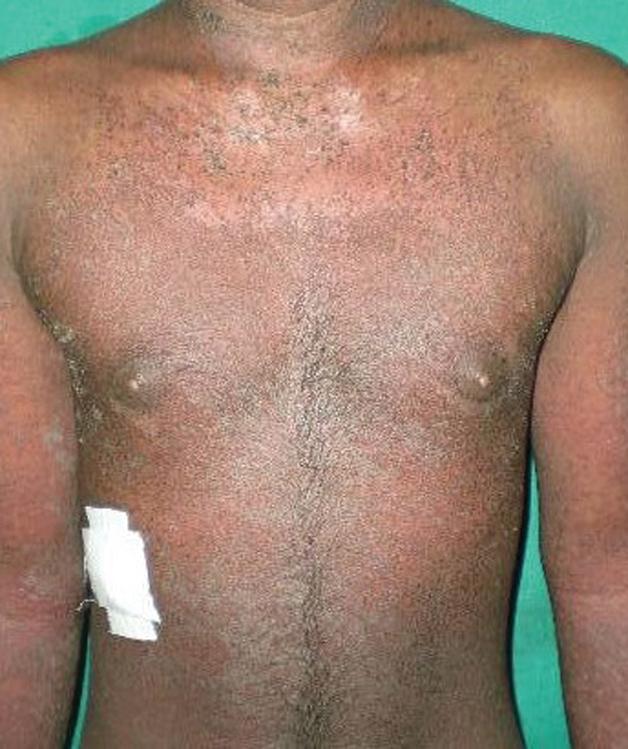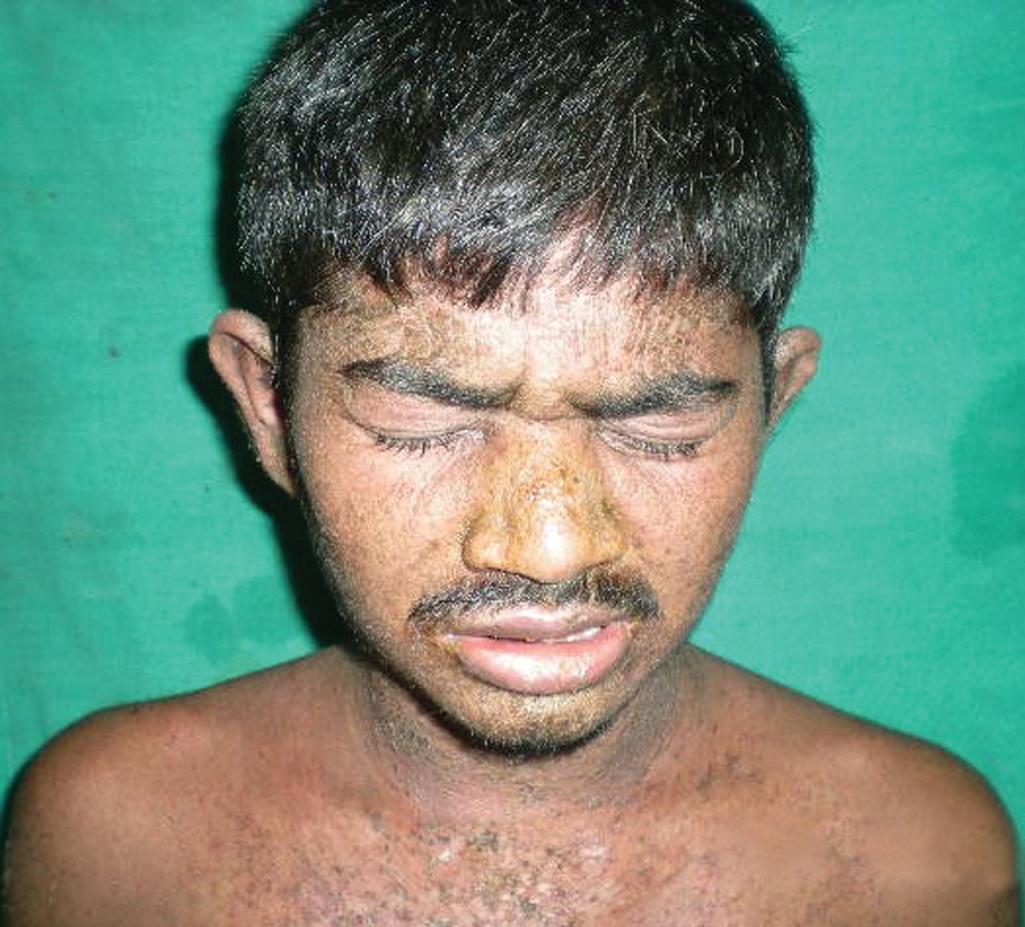Physical Address
304 North Cardinal St.
Dorchester Center, MA 02124
Acute generalized exanthematous pustulosis (AGEP) is an uncommon, severe cutaneous eruption that is attributed to drugs in more than 90% of cases ( Fig. 18.1 ). It is characterized by the rapid development of numerous superficial sterile pustules on an erythematous base. It has an estimated incidence of 1 to 5 cases per million per year. AGEP commonly affects adults and shows a slight female predominance.

AGEP is considered to be a T cell–mediated, sterile, neutrophilic, type IVd hypersensitivity reaction. The rash usually develops within hours to days of drug exposure, with a typical latency of 24 to 48 hours.
Drugs commonly implicated in AGEP include a large number of medications, such as antibiotics (particularly ampicillin/amoxicillin, macrolides, sulfonamides, and quinolones), antifungals (e.g., terbinafine, ketoconazole, fluconazole), hydroxychloroquine, diltiazem, and drugs with weaker association (such as omeprazole, corticosteroids, oxicam nonsteroidal antiinflammatory drugs [NSAIDs], and antiepileptic drugs).
Infections commonly implicated in AGEP are Mycoplasma pneumoniae infection, Chlamydia pneumoniae, Escherichia coli , cytomegalovirus, coxsackie B4, and parvovirus B19.
In terms of systemic symptoms, a fever of at least 100.4° F is almost always present.
AGEP involves numerous pinhead-sized, nonfollicular, sterile pustules on an erythematous, edematous base.
The rash typically begins on the flexural areas and progresses to the trunk and extremities within hours. Many patients are near erythrodermic.
The lesions generally are pruritic and sometimes are associated with a burning sensation.
Mucosal involvement is reported in about 20% of cases and is typically confined to a single site, especially the mouth or lips.
Neutrophilic leukocytosis and elevated C-reactive protein (CRP) levels are common.
Eosinophilia is seen in 30% of cases.
Hypocalcemia is seen in 75% of cases.
Another common laboratory finding is a negative Gram stain and culture of the pustules.
Systemic involvement is reported in 17% of cases and typically include elevated creatinine (kidney injury) and transaminitis (liver injury) levels.
It is essential to distinguish AGEP from other forms of drug reactions, including drug reaction with eosinophilia and systemic symptoms (DRESS), Stevens-Johnson syndrome/toxic epidermal necrolysis (SJS/TEN), and exanthematous drug eruptions.
SJS usually presents within 4 weeks of drug exposure and is characterized by severe, generalized mucosal involvement. In contrast, AGEP presents within 48 hours of drug exposure (typically beta-lactam antibiotics) and is characterized by multiple pinpoint pustules distributed over the whole body. Mucosal involvement in AGEP is usually limited to one site (mostly the mouth) without any erosions. These conditions can be further differentiated based on skin biopsy findings.
Generalized acute pustular psoriasis may be difficult to distinguish from AGEP. Acute generalized pustular psoriasis most commonly occurs in individuals with known psoriasis who have either recently received a course of systemic corticosteroids or have been exposed to another psoriasis exacerbator. History of psoriasis, absence of drug exposure, longer symptom duration, and papillary dilated or tortuous blood vessels, as well as psoriasiform epidermal hyperplasia on histopathology, favor the diagnosis of psoriasis. Drugs can also trigger acute pustular psoriasis; however, the spectrum of inciting drugs differ between these two conditions.
Bullous impetigo is another differential to consider that generally affects children. It clinically manifests as small vesicles or pustules on the face and/or flexural areas. The pustules usually rupture, leaving erosions with a honey-colored crust. In contrast to AGEP, Gram stain and culture of the pustule grows Staphylococcus aureus.
Other pustular eruptions from bacterial or fungal infections can be excluded by clinical picture, history, histopathologic, and smears or cultures of the lesions.
The diagnosis of AGEP is suspected when a patient presents with fever, rapid development of a pustular rash, and recent drug exposure or febrile illness.
A careful review of the patient’s complete medication list, including prescription, over-the-counter (OTC), and herbal medications, should be performed. The timeline of drug exposure and symptoms onset should be documented to assess for drug causality. Travel history and exposure to any ticks should be obtained to evaluate for an infectious etiology.
Tests that should be obtained as a part of the work-up to confirm the diagnosis and exclude other conditions that mimic AGEP include a complete blood count (CBC) with differential and peripheral blood smear, liver function tests, renal function tests, bacterial and fungal cultures from blood, a Gram stain and culture of the pustules, and imaging studies (guided by clinical presentation).
A skin biopsy for histopathologic examination should be performed to support the diagnosis and exclude AGEP mimics. The histologic findings include subcorneal or intraepidermal spongiform pustules, which are associated with dermal edema and a superficial and midperivascular (as well as interstitial) inflammatory infiltrate that contains neutrophils and eosinophils. In contrast to pustular psoriasis, papillary dilated and tortuous blood vessels and psoriasiform epidermal hyperplasia are absent.
In the case of polypharmacy, a patch test can be performed to identify the causative agent.
Identification and prompt withdrawal of the offending agent is the mainstay of treatment. AGEP is a self-limiting disease, and withdrawal of the offending agent results in the resolution of cutaneous manifestations in about 2 weeks. Those with a more generalized skin involvement or older patients may require admission for fluid/electrolyte replacement and nutritional support.
Symptomatic patients (those with pruritus, pain, and/or burning) are generally treated with medium-potency topical steroids.
Fluocinolone acetonide 0.025% ointment (or a similar strength topical steroid) can be applied twice daily for 1 week or until symptoms resolve. It should not be used on the face.
For the face, patients should use hydrocortisone 2.5% cream twice daily (or a similar strength topical steroid) for 1 week or until symptoms resolve.
Acute generalized exanthematous pustulosis (AGEP) is a rare side effect of a medication that affects the skin. The rash appears suddenly after drug exposure and is characterized by multiple small pus-filled spots and skin edema. AGEP is triggered by medications in more than 90% of cases. There was no way to determine that you would get AGEP from the medication that caused your rash before starting that medication. AGEP is caused by a wide variety of drugs, most commonly antibiotics. The list of medications that can potentially cause AGEP will be provided to you. Rarely, AGEP is caused by a viral or bacterial infection.
AGEP is a self-limiting disease and usually resolves without any complications after the causative drug is discontinued. AGEP can happen again after the reintroduction of the causative drug.
In your case, the offending drug should be stopped, and it is recommended that you strictly avoid this drug in the future. Structurally similar drugs can also cause the same reaction, and it is recommended that you discuss with your healthcare provider before starting any new medications. You should learn the names of the medicines you should avoid and keep a written record on your person. Your pharmacy should also make a note that you had a drug reaction and should have a list of medications you should avoid. Consider wearing a medical alert bracelet to let people know which medications to avoid.
Drug reaction with eosinophilia and systemic symptoms (DRESS) is a rare, potentially life-threatening adverse drug reaction with a long latency period.
It was initially described after the introduction of phenytoin and thus was historically called “phenytoin hypersensitivity syndrome.”
Many other medications have since been implicated and numerous names have been used, including “anticonvulsant hypersensitivity syndrome” and “drug-induced hypersensitivity syndrome.”
The term DRESS was coined in the late 1990s and is currently the most accepted terminology.
Clinical manifestations typically appear anywhere from 2 to 8 weeks (with a mean of 3 weeks) after initiation of the culprit drug.
They include fever, malaise, skin eruption, hematologic abnormalities, lymphadenopathy, and visceral involvement.
DRESS is associated with a 10% mortality rate.
The etiology of DRESS is complex and likely involves three factors: a genetic predisposition that alters immune response, a trigger that may involve a viral infection, and a drug to which the patient may have a defect in drug metabolism.
DRESS is fortunately rare, with an incidence ranging from 1 in 1000 to 1 in 10,000 drug exposures.
The frequency varies depending on the drug type and appears to be higher in patients taking anticonvulsants, particularly lamotrigine.
Common drugs implicated in DRESS include anticonvulsants (such as phenytoin, carbamazepine, phenobarbitone, and lamotrigine); antibiotics (e.g., minocycline, dapsone [especially in patients with HLA-B*13:01 haplotype], sulfonamides, beta-lactam antibiotics), antivirals (including nevirapine, telaprevir, raltegravir, and abacavir [HLA-B*5701 haplotype]), allopurinol (especially in patients with HLA-B*58:01 haplotype), and chemotherapeutic/immunotherapeutic agents (such as imatinib, sorafenib, and vemurafenib).
Systemic symptoms include fever, malaise, lymphadenopathy, and symptoms of visceral involvement.
DRESS starts as a morbilliform eruption that rapidly progresses to a diffuse, confluent skin erythema. Some patients complain of pruritus. In about one-fourth of patients, the erythema progresses to exfoliative dermatitis ( Fig. 18.1 ).
It initially involves the face and upper part of the trunk and upper extremities with eventual extension to the lower extremities.
It involves more than 50% of the body surface area (BSA).
Symmetric, persistent, facial edema with erythema is present in more than 50% of cases ( Fig. 18.2 ).

Erythema and tenderness of mucous membranes without erosions are seen in more than half of the cases.
Other less commonly reported features include the development of vesicles, bullae, pustules, target lesions, and purpura.
In terms of systemic involvement, the frequency of organ involvement depends on the inciting agent (e.g., allopurinol-induced DRESS usually causes kidney injury).
With hematologic involvement, leukocytosis with eosinophilia is usually present.
Thrombocytopenia and anemia is rare but sometimes reported.
When the liver is involved, asymptomatic hepatitis (either hepatocellular or cholestatic damage) is more common (70% patients), but patients may also present with hepatomegaly and jaundice.
In severe cases, fulminant hepatic failure may develop and is responsible for most of the mortality associated with DRESS syndrome.
Acute kidney injury (tubulointerstitial nephritis) develops in about 11% of patients, especially in patients on allopurinol.
It is manifested by a rise in blood urea nitrogen (BUN) and creatinine levels.
Other features include low-grade proteinuria and abnormal urinary sediment with eosinophils.
Lung involvement may include interstitial pneumonitis with nonspecific symptoms of cough and difficulty breathing.
Hypoxemia is also sometimes present.
Become a Clinical Tree membership for Full access and enjoy Unlimited articles
If you are a member. Log in here